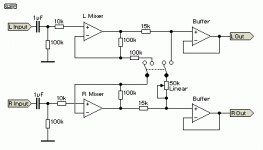Well not really a 'boombox', I'm attempting to build a classy portable stereo system to play MP3s, etc.
Both speakers will be fixed in the cabinet and non-detachable (for simplicity). Therefore they won't be as far apart as I would like. I am therefore looking for a circuit that can expand the stereo image so that the music appears to come from beyond the speakers.
Can anyone advise?
Also, should this be posted in another part of the forum? Things are getting complicated around here?
Regards
Steve
Both speakers will be fixed in the cabinet and non-detachable (for simplicity). Therefore they won't be as far apart as I would like. I am therefore looking for a circuit that can expand the stereo image so that the music appears to come from beyond the speakers.
Can anyone advise?
Also, should this be posted in another part of the forum? Things are getting complicated around here?
Regards
Steve
I've seen a circuit someplace. I think it just used an opamp to subtract a variable amount of each channel from the opposite one. Lout=Lin - (some fraction of)Rin. The pot could be wired to offer a range from full blend (mono) to normal to full wide (the blend range might be good for headphone listening). A quad op-amp wired as two inverting buffers feeding two inverting virtual-ground mixers.
Here you go:
Stereo Width Controllers
If the driving impedance is reasonably low, it should be OK to omit the non-inverting buffers and just use a quad opamp.
It's possible that someone like Rohm made a chip that did this. It was a fairly common feature for ghetto blasters, and might be found in some TVs.
Bass tends to be essentially mono, so making it wider will tend to reduce the bass in both channels. This might be a good time to consider biamping with a mono subwoofer. (Use a DVC sub so both sides of a T-amp can drive it.) Inserting a high-pass filter in the crossfeed signals should work... just a couple of series caps. Presumably the image information is mostly in the high frequencies.
Here you go:
Stereo Width Controllers
If the driving impedance is reasonably low, it should be OK to omit the non-inverting buffers and just use a quad opamp.
It's possible that someone like Rohm made a chip that did this. It was a fairly common feature for ghetto blasters, and might be found in some TVs.
Bass tends to be essentially mono, so making it wider will tend to reduce the bass in both channels. This might be a good time to consider biamping with a mono subwoofer. (Use a DVC sub so both sides of a T-amp can drive it.) Inserting a high-pass filter in the crossfeed signals should work... just a couple of series caps. Presumably the image information is mostly in the high frequencies.
Last edited:
Here you go:
Stereo Width Controllers
If the driving impedance is reasonably low, it should be OK to omit the non-inverting buffers and just use a quad opamp.
It's possible that someone like Rohm made a chip that did this. It was a fairly common feature for ghetto blasters, and might be found in some TVs.
Bass tends to be essentially mono, so making it wider will tend to reduce the bass in both channels. This might be a good time to consider biamping with a mono subwoofer. (Use a DVC sub so both sides of a T-amp can drive it.) Inserting a high-pass filter in the crossfeed signals should work... just a couple of series caps. Presumably the image information is mostly in the high frequencies.
The circuit is simple enough but does anyone know of a chip available? I have an old EQ with this effect and have not ripped into it yet.
Attachments
Last edited:
The circuit is simple enough but does anyone know of a chip available? I have an old EQ with this effect and have not ripped into it yet.
Just use an a pair of dual or a quad opamp's of your choice!!
I still use the TL082's and TL084's even to this day for great quality and low price !!!
jer
Just use an a pair of dual or a quad opamp's of your choice!!
I still use the TL082's and TL084's even to this day for great quality and low price !!!
jer
In that case... I think I already have all the parts.
Thanks, Ron
Any reason you can't use the built-in DSP in the source? Doesn't matter if it's a laptop or mobile phone you have as source, they're still capable running professional DSP software.
That is a great idea if it is available. The source will be an iPhone broadcasting to a bluetooth device in a battery powered boombox type system for outdoor use. Nothing as fancy or well planned out as the Boominator, but along those lines. The speakers will be close together so I figured I would put something to give the illusion. I started off thinking BBE Sonic Maximizer, moved on to stereo expander but the software route would be great. Would be nice though if anyone with bluetooth had the effect built into the box. I took the stereo widener card out of a Realistic EQ and might be able to wire it in. The longer I delay starting this project the more simplified it is becoming. Went from 24v to 12v. From woofs, tweets, xo's and ports to full range closed box. Will be using 4 5x7 4ohm Ford speakers and a 4x100 t-amp. I don't expect greatness but should dazzle the crowd I tend to spring it on. Any suggestions on specific apps?
- Status
- This old topic is closed. If you want to reopen this topic, contact a moderator using the "Report Post" button.
- Home
- Source & Line
- PC Based
- Need 'stereo expander' circuitry for boombox
